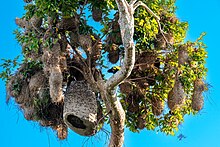Yellow-rumped cacique
| Yellow-rumped cacique | |
|---|---|

| |
| in Brazil | |
| Scientific classification | |
| Domain: | Eukaryota |
| Kingdom: | Animalia |
| Phylum: | Chordata |
| Class: | Aves |
| Order: | Passeriformes |
| Family: | Icteridae |
| Genus: | Cacicus |
| Species: | C. cela
|
| Binomial name | |
| Cacicus cela | |

| |
| Global range (green) | |
| Synonyms | |
| |

The yellow-rumped cacique (Cacicus cela) is a
Taxonomy
The yellow-rumped cacique was
Three subspecies are recognised:[7]
- C. c. vitellinus Lawrence, 1864 – Panama Canal Zone to north and central Colombia
- C. c. flavicrissus (Sclater, PL, 1860) – west Ecuador and northwest Peru
- C. c. cela (Linnaeus, 1758) – east Colombia and Venezuela, the Guianas, south to central Bolivia and south Brazil
The first two subspecies may be a separate species, the saffron-rumped cacique.[8]
Description
The male is on average 28 centimetres (11 in) long and weighs about 104 grams (3.7 oz), with the female 23 centimetres (9.1 in) long and weighing approximately 60 grams (2.1 oz). The yellow-rumped cacique is a slim bird, with a long tail, blue eyes, and a pale yellow pointed
The
Distribution and habitat

The yellow-rumped cacique is a bird associated with open woodland or cultivation with large trees.
Behaviour and ecology


This gregarious bird eats large insects (such as beetles, caterpillars, crickets, grasshoppers and katydids),[9][10] spiders[9] (such as orb-weavers),[10] nectar[9][10] and fruit (such as chupa-chupa and figs).[10]
Breeding
It is a colonial breeder, with up to 100 bag-shaped
Relationship with humans
The yellow-rumped cacique has benefited from the more open habitat created by forest clearance and ranching. It is not considered threatened by the
In
References
- . Retrieved 18 November 2021.
- ^ Linnaeus, Carl (1758). Systema Naturae per regna tria naturae, secundum classes, ordines, genera, species, cum characteribus, differentiis, synonymis, locis (in Latin). Vol. 1 (10th ed.). Holmiae (Stockholm): Laurentii Salvii. p. 191.
- ISBN 978-1-4081-2501-4.
- ^ Hellmayr, Carl Eduard (1906). "On the birds of the island of Trinidad". Novitates Zoologicae. 13: 1–60 [20].
- ^ Paynter, Raymond A. Jr, ed. (1968). Check-List of Birds of the World. Vol. 14. Cambridge, Massachusetts: Museum of Comparative Zoology. p. 145.
- ^ Lacépède, Bernard Germain de (1799). "Tableau des sous-classes, divisions, sous-division, ordres et genres des oiseux". Discours d'ouverture et de clôture du cours d'histoire naturelle (in French). Paris: Plassan. p. 6. Page numbering starts at one for each of the three sections.
- ^ Rasmussen, Pamela, eds. (2020). "Oropendolas, orioles, blackbirds". IOC World Bird List Version 10.2. International Ornithologists' Union. Retrieved 13 December 2020.
- ^ a b Jaramillo & Burke (1999)
- ^ a b c "Cacicus cela (Yellow-rumped Cacique)" (PDF). Sta.uwi.edu. Retrieved 10 April 2022.
- ^ a b c d "Cacicus cela (Yellow-rumped cacique)". Animaldiversity.org. Retrieved 10 April 2022.
- ^ BLI (2008)
- ^ moyobamba.com (2007), Enjoy Peru [2008]
Sources
This article includes a list of general references, but it lacks sufficient corresponding inline citations. (January 2010) |
- Cuervo, Andrés M.; Hernández-Jaramillo, Alejandro; Cortés-Herrera, José Oswaldo & Laverde, Oscar (2007): Nuevos registros de aves en la parte alta de la Serranía de las Quinchas, Magdalena medio, Colombia [New bird records from the highlands of Serranía de las Quinchas, middle Magdalena valley, Colombia]. Ornitología Colombiana 5: 94–98 [Spanish with English abstract]. PDF fulltext
- Enjoy Peru [2008]: Manu – Aves. Retrieved 2008-DEC-22.
- moyobamba.com (2007): Leyendas e historia de los barrios. Retrieved 2007-SEP-28.
- Jaramillo, Alvaro & Burke, Peter (1999): New World Blackbirds. ISBN 0-7136-4333-1
Further reading
- Skutch, Alexander F. (1954). "Yellow-rumped cacique" (PDF). Life Histories of Central American Birds. Pacific Coast Avifauna, Number 31. Berkeley, California: Cooper Ornithological Society. pp. 305–315.
- ffrench, Richard; O'Neill, John Patton & Eckelberry, Don R. (1991): A guide to the birds of Trinidad and Tobago (2nd edition). Comstock Publishing, Ithaca, N.Y.. ISBN 0-8014-9792-2
- Hilty, Steven L. (2003): Birds of Venezuela. ISBN 0-7136-6418-5
External links
- Yellow-rumped cacique videos, photos and sounds – Internet Bird Collection
- Yellow-rumped cacique photo gallery – VIREO

